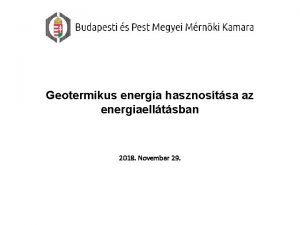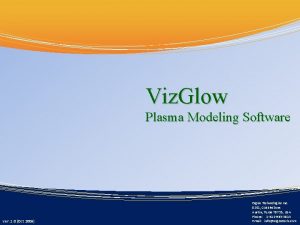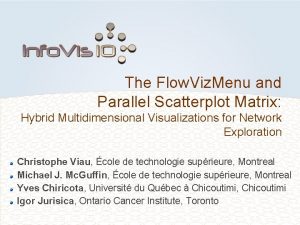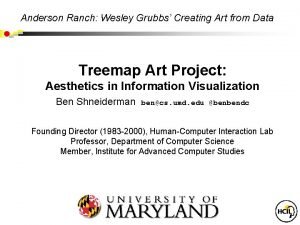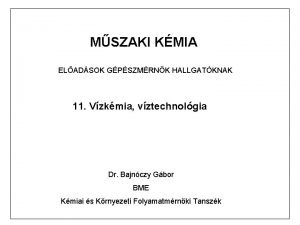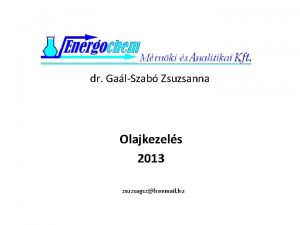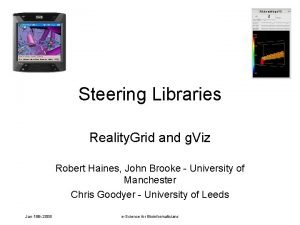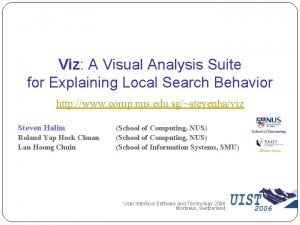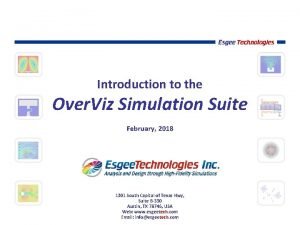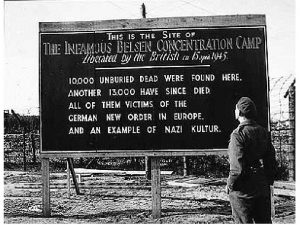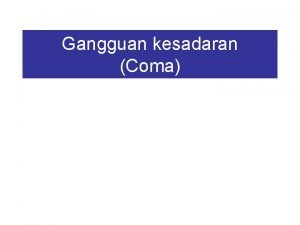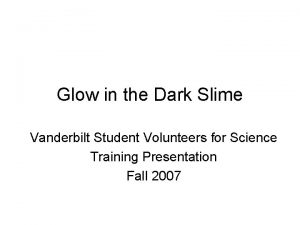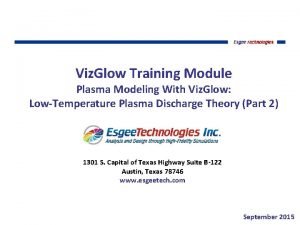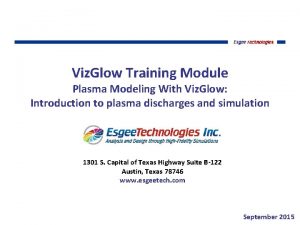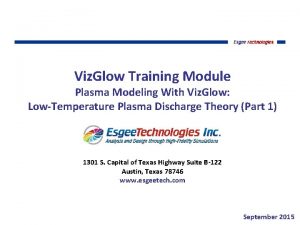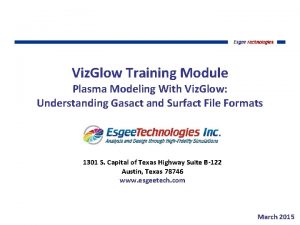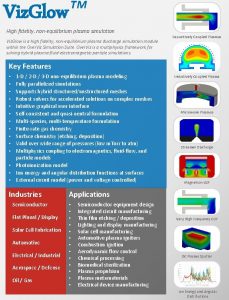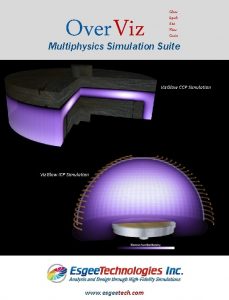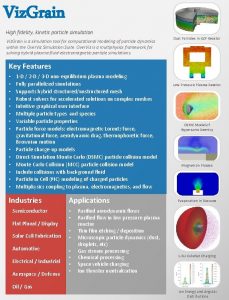Viz Glow Training Module Plasma Modeling With Viz




















































- Slides: 52

Viz. Glow Training Module Plasma Modeling With Viz. Glow: Low-Temperature Plasma Discharge Theory (Part 1) 1301 S. Capital of Texas Highway Suite B-122 Austin, Texas 78746 www. esgeetech. com September 2015

2 COPYRIGHT AND CONFIDENTIALITY STATEMENT Copyright © (2007 -2015) Esgee Technologies, Inc. All rights reserved. This manual accompanies software that is provided to users under a license agreement. This manual can also be provided under a non-disclosure agreement and is subject to restrictions on confidential information under such an agreement. The manual contains proprietary information and may not be disclosed to a third party not covered by the license agreement or a non-disclosure agreement. No part of this manual may be reproduced in any form or by any means without express written permission from Esgee Technologies, Inc.

3 Collisions and cross sections

Charged particle dynamics in the presence of an electric field § Charged particles gain energy from an electric field - § As charged particles move, they collide with neutrals (or ions, or electrons) - + collision 4

5 Cross sections § When two particles collide, momentum and (total) energy is conserved § Elastic collision : the kinetic energy of the colliding particles is conserved § Inelastic collision : the kinetic energy of the colliding particles is not conserved (change in internal energy of one or both particles) § The same two colliding particles can produce different results depending on their energies (more specifically, the relative velocity) just before the collision § Cross sections are quantities to help analyze and understand collisions between two or more particles (only considering two body collisions in this section)

6 Collision cross section definition § Number Velocity of test density of test particles relative to particles field particles Electrons “Test particles” (1) Neutrals “Field particles” (2)

7 Differential scattering cross section (1/2) § Collisions can also be classified based on the angle by which the test particle is scattered by the field particle (solid angle in x 3 -D) z y § The differential scattering cross section can be defined as

8 Differential scattering cross section (2/2) Test particle θ Impact parameter b χ Field particle §

9 From Differential to Integral cross section §

10 Example: hard sphere cross section § The differential cross section for hard sphere collisions, assuming azimuthal symmetry: θ a 1 b Differential cross section for hard sphere collisions χ a 2

Binary collisions: center of mass frame (1/2) § For binary collisions between particles with mass and Collision § The collision can be considered in the center of mass frame Center of mass velocity Relative velocity § From momentum conservation , the center of mass velocity after the collision does not change 11

Binary collisions: center of mass frame (2/2) § For elastic collisions, total kinetic energy is conserved § Transforming to the center of mass frame and simplifying, § For elastic collisions, the magnitude of the relative velocity does not change 12

13 Momentum transfer cross section § The momentum transfer cross section can be defined as § Loss in z-component of momentum flux § Momentum transfer cross section θ § For hard sphere collisions χ

14 Electron impact cross section examples § § Cross section data typically plotted as a function of electron energy Magnitudes tend to be in the range 10 -21 – 10 -18 m 2 (0. 1 -100 Å2) Excitation and Ionization processes have a threshold energy Molecular gases have rotational and vibrational excitation in addition to electronic excitation

15 Collision rate definition §

16 Collision frequency and mean free path §

17 Distribution functions and Boltzmann’s equation

18 Distribution functions § A distribution function is defined as = number of particles inside a sixdimensional phase space volume at location and time

19 The Boltzmann equation § The Boltzmann equation is a continuity equation in phase space with the species distribution function as the dependent variable § For plasmas, the force is given by § The source term of the Boltzmann equation is the “collision integral”

Equilibrium solution: The Maxwellian distribution function § Molecules in a gas reach equilibrium by colliding with other molecules (of the same species) § At equilibrium, the net effect of collisions is zero, i. e Steady No gradients No acceleration § The solution to the Boltzmann equation at equilibrium is the Maxwellian distribution function (velocity distribution function) 20

21 The Maxwellian distribution function § The solution to the Boltzmann equation at equilibrium is the Maxwellian distribution function (velocity distribution function) Isotropic- No dependence on any particular velocity direction § The corresponding speed distribution function is “Tail”

The Electron Energy Distribution Function (EEDF) and Probability Function (EEPF) § Electron Energy Distribution Function Electron Energy Probability Function 22

23 Maxwellian EEPF § “Tail”

Question: why/when is the electron distribution in a plasma not Maxwellian? § Assume electrons in a plasma are initially in equilibrium (characterized by Maxwellian distribution) § If a spatially varying electric field is present (for example in a CCP or DC discharge), individual electrons gain different amounts of energy from the electric field depending on their location, thus representing a perturbation from equilibrium § The mechanism for electrons to reach equilibrium is collisions with other electrons § In a low temperature plasma at intermediate/high pressure, lots more neutrals compared to electrons (weakly ionized), which makes it difficult for electrons to regain equilibrium § High energy electrons colliding with neutrals result in excitation and ionization- loss of energetic electrons (depletion of the “tail”), further distortion from equilibrium § Electron distribution function in low temperature plasmas is non-Maxwellian in many cases § (exceptions- high plasma density discharges, some wave-heated plasmas) 24

25 Solving for the distribution function §

26 The two-term approximation § Isotropic part Anisotropic part Separation of variables - space and time-dependence and velocity(energy) dependence

27 Analytical Solution of the two-term approximation: Maxwellian and Druyvesteyn distributions (1/2) § Collision frequency

28 Analytical Solution of the two-term approximation: Maxwellian and Druyvesteyn distributions (2/2) § The solution can be further simplified by specifying a functional dependence of the collision frequency on the velocity § If the collision frequency is constant (independent of velocity), the isotropic solution is a Maxwellian distribution § If the collision cross section is constant (constant mean free path) , i. e. collision frequency is proportional to velocity, then the isotropic solution is a Druyvesteyn distribution

Numerical solution to two-term approximation: example 1 EEPF (e. V-3/2) § EEPFs in argon, mean energy 3 e. V § EEPF from two-term approximate numerical solution to Boltzmann solution shows sharper drop at “tail” of the distribution function (primarily due to inelastic collisions) mean energy Energy (e. V) [1] Hagelaar and Pitchford, PSST, 2005 29

From distribution functions to Macroscopic quantities § Macroscopic quantities can be obtained by taking moments of the distribution function (integrals over velocity space § Number density § Mean velocity § Mean energy density 30

31 Some macroscopic quantities for Maxwellian distribution function § Some macroscopic quantities for Maxwellian distribution function (integrals over velocity space) § Number density § Mean (average) speed § Mean (average) energy density By definition

32 Average particle flux to a surface § The average particle flux to a surface can be calculated θ § For a Maxwellian distribution function, the average particle flux to the surface is

33 Average energy flux to a surface § The average energy flux to a surface can be calculated θ § For a Maxwellian distribution function, the average energy flux to the surface is

34 Fluid models and approximations

The Boltzmann equation and fluid equations § A fluid model of plasmas can be obtained by taking moments of the Boltzmann equation Conservation of mass Conservation of momentum Conservation of energy § The resulting equations are the conservation of mass, momentum and energy of each species ((1+D+1)Nspecies equations, eg 5 Nspecies equations for 3 -D case) 35

36 Conservation of mass (1/3) §

37 Conservation of mass (2/3) Reaction source terms § Integral gives the reaction rate coefficient at a particular temperature

Conservation of mass (3/3) Reaction rate coefficient example § The electron energy distribution function influences the reaction rate coefficient (for example, ionization of argon) 38

39 Conservation of momentum § Inertial terms Electrostatic Force term Pressure Friction/drag term

40 The Drift-Diffusion approximation (1/3) § Starting from the conservation of momentum § If the inertial terms (left hand side) are small compared to the forcing terms Drift-Diffusion approximation Drift term Diffusion term

The Drift-Diffusion approximation (2/3) Einstein’s relation § Drift-Diffusion approximation Mobility Diffusion Coefficient 41

Drift-Diffusion approximation (3/3) From the two-term approximation § The Drift-Diffusion approximation can be derived directly from the two-term approximation of the Boltzmann equation (for electrons)1 § When the distribution function deviates from Maxwellian, then Einstein’s relation is not strictly valid for all cases (but useful approximation where we lack information) [1] Hagelaar and Pitchford, PSST, 2005 42

43 Specifying transport coefficient data § Transport coefficient data is typically prescribed in the form of lookup tables or curve fit § In the Local Field Approximation (LFA), transport coefficients are considered to be functions of the reduced electric field (E/N) § In the Local Mean Energy Approximation (LMEA), transport coefficients are considered to be functions of the temperature (or mean energy) Ref: Mahadevan and Raja, JAP, 2010

44 Drift-Diffusion approximation Modification due to magnetic field § For cases where magnetic field effects are important, the conservation of momentum (with inertial terms neglected) is 3 equations, 3 unknowns Drift-Diffusion approximation with magnetic field effect Transport coefficients are tensors

45 Quasi-neutral approximation § The plasma model for species fluxes can be further simplified for cases where quasi-neutrality is assumed Quasi-neutral § To maintain quasi-neutrality, an additional constraint that applies is Assumes no driving current at boundary (floating) Equation for the electric field in terms of density , not strictly consistent with Gauss’ law

46 The ambipolar electric field §

47 The ambipolar diffusion coefficient (1/2) § The species flux expression for the quasi-neutral approximation takes the form (Fick’s law of diffusion) § The resulting effective diffusion coefficient for electrons and ions is called the ambipolar diffusion coefficient § The species conservation equation for the quasi-neutral approximation is

48 The ambipolar diffusion coefficient (2/2) § The ambipolar diffusion coefficient can be simplified further by noting that the electron mobility is much larger than the ion mobility § Using Einstein’s relation § The ambipolar diffusion coefficient can be expressed as

49 Boltzmann relation for electrons § Consider the momentum equation for electrons with inertial terms neglected § If the friction term is also negligible, then the momentum balance is reduced to a force balance between electric field and pressure forces Assume isothermal electrons Boltzmann relation

50 Debye Length Boltzmann electrons and fixed ions § Sheet of negative charge x x Debye length

51 Conservation of energy § convection terms Thermal flux Joule heating Energy source term due to collisions

End of presentation www. esgeetech. com
 Víz-víz hőszivattyú vízigénye
Víz-víz hőszivattyú vízigénye Plasma modeling software
Plasma modeling software Modeling role modeling theory
Modeling role modeling theory Relational modeling vs dimensional modeling
Relational modeling vs dimensional modeling Flow viz
Flow viz Vghd
Vghd Víz fázisdiagramja
Víz fázisdiagramja Fin viz map
Fin viz map Hőmérők fajtái
Hőmérők fajtái Víz vastalanítása
Víz vastalanítása Viz is neis
Viz is neis Durranógáz
Durranógáz Víz fázisdiagramja
Víz fázisdiagramja Hínárnövények
Hínárnövények G-viz
G-viz Tengervíz fagyáspontja
Tengervíz fagyáspontja Antiphlogistin pakolás
Antiphlogistin pakolás Viz online suite
Viz online suite Koenzimek
Koenzimek Viz online suite
Viz online suite C device module module 1
C device module module 1 Modeling and imitation training aba
Modeling and imitation training aba Kentucky glow caverns
Kentucky glow caverns Health and glow turnover
Health and glow turnover Glow sticks of steel
Glow sticks of steel Zero-english.com
Zero-english.com Glow discharge tem
Glow discharge tem Warm glow altruism
Warm glow altruism Darvel primary school staff
Darvel primary school staff Minipcr dna glow lab answers
Minipcr dna glow lab answers The graceful slopes glow even clearer
The graceful slopes glow even clearer She walks in beauty rhyme scheme
She walks in beauty rhyme scheme Glow stick lab
Glow stick lab Echinops bannaticus the giant
Echinops bannaticus the giant Material x blender
Material x blender Kamoteng kahoy go grow glow
Kamoteng kahoy go grow glow When the lights all shine
When the lights all shine Vultures chinua achebe
Vultures chinua achebe Glow stick light painting
Glow stick light painting Glow gurt
Glow gurt Tissue imtiaz dharker context
Tissue imtiaz dharker context Mind rhyming words
Mind rhyming words Blinkin rev
Blinkin rev Glow-worms
Glow-worms Yaunkauer
Yaunkauer Gcs indonesia
Gcs indonesia In mrs tilscher's class annotated glow
In mrs tilscher's class annotated glow Glow-in-the-dark slime
Glow-in-the-dark slime The graceful slopes glow even clearer
The graceful slopes glow even clearer Team building module
Team building module Iec and bcc difference
Iec and bcc difference Ostp test administration training
Ostp test administration training Hbyc age
Hbyc age
